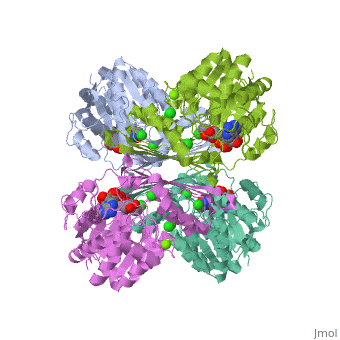Samantha Stone Sandbox
From Proteopedia
(Difference between revisions)
| Line 18: | Line 18: | ||
<scene name='Samantha_Stone_Sandbox/Mn_cza__ii_binding_site/1'>Mn II CZA Binding Site</scene> | <scene name='Samantha_Stone_Sandbox/Mn_cza__ii_binding_site/1'>Mn II CZA Binding Site</scene> | ||
| - | + | ||
| + | |||
| + | The following picture shows the M1-M10 helices that are involved sarco(endo)plasmic reticulum Ca2+-ATPase (SERCA). The M1 helix has a kink that is a part of all P-type ATPases. This kink is involved in cytoplasmic cation access pathway | ||
http://www.jbc.org/content/284/20/13513/F1.large.jpg | http://www.jbc.org/content/284/20/13513/F1.large.jpg | ||
Revision as of 20:07, 20 April 2011
This is the 3FPB Membrane Protein.
Its structure consists of ATP, adenosine 5'-(beta,gamma-methylene)triphosphate (AMPPCP), and cyclopiazonic acid (CZA). A metal (Mg or Mn) must react in the ATP binding site for CZA to bind and react. This occurs at the M1 helix.
| |||||||||
| 3cin, resolution 1.70Å () | |||||||||
|---|---|---|---|---|---|---|---|---|---|
| Ligands: | , , | ||||||||
| Gene: | TM1419, TM_1419 (Thermotoga maritima MSB8) | ||||||||
| Activity: | Inositol-3-phosphate synthase, with EC number 5.5.1.4 | ||||||||
| |||||||||
| |||||||||
| Resources: | FirstGlance, OCA, RCSB, PDBsum, TOPSAN | ||||||||
| Coordinates: | save as pdb, mmCIF, xml | ||||||||
The following picture shows the M1-M10 helices that are involved sarco(endo)plasmic reticulum Ca2+-ATPase (SERCA). The M1 helix has a kink that is a part of all P-type ATPases. This kink is involved in cytoplasmic cation access pathway



